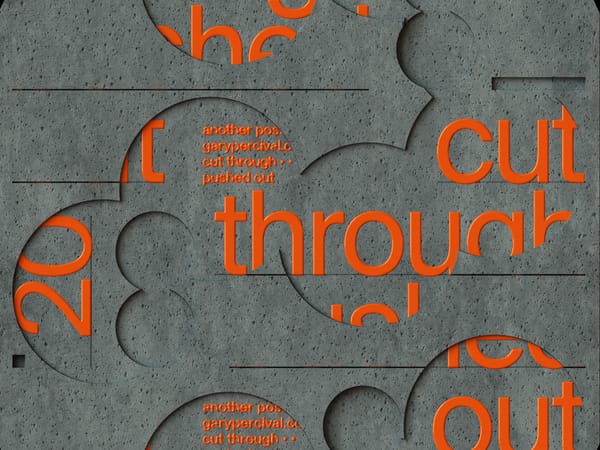The Art of Distraction: Why Your Creative Brain Wanders
Letting your mind roam free from the task at hand may actually benefit creative thinking more than forcing focused concentration.


Have you ever been deep into a creative project only to find your mind drifting elsewhere? Maybe you're designing a logo but suddenly pondering what's for dinner. Or writing copy but distracted by the philosophical implications of your favourite Netflix series.
As creatives, we've all experienced the frustration of our wandering minds. We berate ourselves for losing focus. However, mind wandering and distraction aren't necessarily enemies of creativity; they're integral parts of the creative process itself.
Letting your mind roam free from the task at hand may actually benefit creative thinking more than forcing focused concentration.
Daydreaming and allowing thoughts to stray is how your brain makes new connections, sees different perspectives, and arrives at innovative ideas.
In this post, I'll explore the cognitive science behind why skilled creatives simply can't suppress mind wandering. I'll make the case for why you should embrace and cultivate "distraction" as part of your creative process. And I'll share tips for letting your mind roam productively without derailing your day.
The Default Mode Network
The default mode network (DMN), a network of interconnected brain regions most active when not focused on external tasks or stimuli, provides the explanation. The DMN fires up when your mind wanders, becoming engaged in spontaneous, inwardly focused thoughts like daydreaming, recalling memories, and combining diffuse ideas.
While a wandering mind seems at odds with effort, the DMN is a core neural network that allows decoupling awareness from the external world for creative thinking. Research shows that increased DMN activity correlates with better performance on creative problems requiring innovative idea generation.
The DMN enables cognitive processes key to creative cognition, like imagination, recombining remote ideas, seeing from new perspectives, and making analogical connections. In fact, professional creatives exhibit higher resting DMN activity compared to non-creatives.
The bottom line? If your brain wanders while trying to be creative, don't fight it—that's your powerful default mode network setting the stage for innovation.
The Incubation Effect
The "incubation effect" also explains how mind wandering facilitates creativity. This refers to the way that stepping away from consciously working on a problem can somehow allow your brain to keep working at it subconsciously, leading to insights and breakthroughs when you return to it later.
The classic example is Archimedes having his "Eureka!" moment about volume displacement after taking a bath and letting his mind wander. Modern research backs this up, showing that people who take breaks perform better on creative puzzles than those who work continuously.
Conscious effort alone isn't enough for creative problem-solving. We need to let our unconscious mind keep crunching in the background.
That's when subconscious insights bubble up, like Archimedes's realisation from his bathtub daydream.
Distraction Fuels Inspiration
Distractions and mind wandering also feed creativity by exposing you to new thoughts and experiences that can become inspirations. The brain is masterful at making new connections between seemingly unrelated concepts, but it needs diverse inputs and stimuli to innovatively combine.
When you let your mind roam and get "distracted," you encounter fresh observations and perspectives that start intermingling with ideas you're already working on. Following those trails of curiosity often leads to insights you wouldn't arrive at through narrow concentration alone.
For example, perhaps as a graphic designer, you get distracted pondering patterns in nature. Or, as a writer, daydreaming about your local coffee shop's human theatre. Your wandering mind just intersected disparate ideas like design/flora and human behaviour/coffee cultures—novel combos that could spark a creative breakthrough.
The most innovative minds aren't laser-focused constantly but allow their attention to roam widely across disciplines. That varied grist provides more raw material for the brain to blend into original ideas. So embrace distractions as creative refuelling opportunities.
Deliberate Daydreaming
While spontaneous mind wandering has value, you can also deliberately use "distracted" states as a creative technique. Visual creatives practice "long, slow looking," letting their eyes unfocus to allow new perspectives to emerge when observing subjects.
Writers may go for walks without devices or music, simply to contemplate and make new mental connections. Problem-solvers use open-monitoring meditation to capture subconscious thoughts bubbling up during transitional semidream states.
The key is capturing those inspired detours, so keep an idea journal. Jot down creative thoughts, analogies, or inspiration fragments that arise from cultivating a wandering mind and eye.
By embracing "non-focus," you're upshifting into your default mode network for combining disparate ideas. Deliberate daydreaming may feel unproductive initially, but it can be a powerful creative technique when practiced mindfully.
This intentional use of "unfocused" states ties into the concept of "divergent thinking"—the a ability to generate multiple creative ideas by exploring many possible solutions. Research shows that taking breaks for mind-wandering actually enhances divergent thinking abilities. By allowing your mind to freely associate and explore tangents without judgement, you open up wider possibilities for innovative problem-solving later on.
So don't feel guilty about scheduling some "distraction time" into your day. Whether it's a daily walk, a doodling session, or simply staring out the window, give yourself permission to drift off and daydream. Those seemingly idle moments are fertile ground for your subconscious to plant the seeds of your next creative breakthrough.
Quieting the Overthinking Mind
Mind-wandering also provides a break from your conscious, analytical brain, which can hinder the free flow of ideas. When intensely focused in problem-solving mode, you engage areas handling logic, planning, and critical evaluation.
While essential at times, those cognitive skills can lead to overthinking and judging partial ideas too quickly before they develop. The freethinker and inner critic battle, blocking free associations and leading to novel combinations.
Letting your mind wander creates psychological distance from that intense focus and scrutiny.
It's an opportunity to temporarily deactivate analytical, self-evaluative networks and settle into open monitoring, allowing your default mode network to make new connections automatically without scrutinising every thought.
Creatives often describe this as entering a state of "flow"—present and attuned to their stream of consciousness, but without overthinking static. It's this disciplined spontaneity where original ideas can start coalescing.
Of course, intense focus is essential too. But by alternating periods of diligent concentration with restorative mind-wandering breaks, you strategically engage and rest different brain networks to prime innovative thinking.
Conclusion
Those distracted "zoning out" moments aren't simply lapses; they're core ingredients for innovative thinking. From the default mode network's neural mechanisms to phenomena like the incubation effect, our brains fundamentally require periods of open-ended roaming to feed the creative process.
Mind wandering exposes us to new stimuli intermingling with current ideas, allowing for surprising associations. It activates brain states, promoting cognitive flexibility, abstract thinking, and reduced judgmental rumination. And it gives our unconscious critical time to cultivate insightful solutions behind the scenes.
Rather than fighting it, strategically embrace mind-wandering within your creative workflow. Set aside intentional "daydreaming" sessions and keep an idea journal. Balance intense, focused work with rejuvenating wandering breaks to undercut overthinking. Follow those trails of curiosity; they may lead to your next breakthrough.
Harness the power of deliberate mind-wandering and divergent thinking to expand your creative potential. Embrace those mental tangents as opportunities for your subconscious to plant seeds of insight. And when the time comes, return to focused mode, ready to reap the innovative fruits of your daydreaming labour.
The next time you find yourself becoming "distracted," don't be so hard on yourself. It's possible that your mind is simply seeking inspiration through scenic routes. Enjoy those mental meanderings; they're part of the captivating art of how creativity unfolds.



